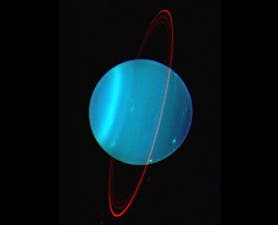
Uranus, the seventh planet from the sun, is a definite oddball of the solar system. It has its axis titled by a whopping 98 degrees, which makes it orbit on its side. The general accepted theory is that a big impact with an object several times the size that of the Earth nodged its axis massively, however a new study presented recently at the EPSC-DPS Joint Meeting in Nantes rewrites our theories of how Uranus became so tilted and gives new valuable insight as to how giant planets form.
As a comparisson Jupiter’s spin axis is only tilted by 3 degrees; Earth’s, 23 degrees; Saturn and Neptune, 29 degrees. Seeing how Neptun’s axis is tilted more than 3 times that of the second titled axis in the solar system has always puzzled astronomers. For many years now, the leading hyphotesis was that of a giant space object, a few times the size of Earth, plunged into the giant planet and deviated its axis. The one, major flaw to this supposition, however, is that, if true, Uranus’ moons should have been left orbiting in their original angles, but they too lie at almost exactly 98 degrees.
The answer, scientists say, is that Neptun was struck in multiple high impacts, instead of one. Alessandro Morbidelli (Observatoire de la Cote d’Azur in Nice, France), lead study author, and his international team of scientists used complex planetary simulations to reproduce various impact scenarios in order to ascertain the most likely cause of Uranus’ tilt. They discovered that if Uranus had been hit when still surrounded by a protoplanetary disk – the material from which the moons would form – then the disk would have reformed into a fat doughnut shape around the new, highly-tilted equatorial plane.
Planet formation theory revised
With this set-up simulation in place, however, the moons displayed a retrograde motion, opposite to the motion that can be observed today. Their explanation: Uranus was not tilted in one go, as is commonly thought, but rather was bumped in at least two smaller collisions, then there is a much higher probability of seeing the moons orbit in the direction we observe.
“The formation history of Uranus and Neptune is one of the most important open problems in planetary science. Having shown that giant collisions had to happen frequently on these planets is an important piece of information on the way to understanding their origin,” lead author Alessandro Morbidelli, with the Observatory of Cote d’Azur in Nice, France, wrote in an email to Discovery News.
Morbidelli’s research is currently conflicting current planetary formation theories, which might need to be revised.
“The standard planet formation theory assumes that Uranus, Neptune and the cores of Jupiter and Saturn formed by accreting only small objects in the protoplanetary disk. They should have suffered no giant collisions. The fact that Uranus was hit at least twice suggests that significant impacts were typical in the formation of giant planets. So, the standard theory has to be revised.”


